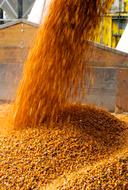ICM Inc. has announced the successful startup and commissioning of its FOT Oil Recovery system at Elite Octane LLC’s ethanol facility in Atlantic, Iowa. The newly installed system is exceeding anticipated oil recovery and performance targets.
LanzaTech Global Inc. has announced its plans to expand its biorefining platform capabilities to include operations that produce LanzaTech Nutritional Protein (LNP) as the primary product via its proprietary gas fermentation process.
EPM has collected information on 120 U.S. ethanol plants that are capturing their fermentation carbon dioxide—or intend to—for one of three principal purposes: conventional utilization, sequestration or next-gen transformation.
The U.S. exported 141.19 million gallons of ethanol and 1.12 million metric tons of distillers grains during August, according to data released by the USDA on Oct. 8. Exports of both products were up when compared to the previous year.
POET is deploying ImagoAI’s Galaxy mycotoxins testing technology across approximately 30% of its fleet. This new addition to POET’s testing regime will significantly reduce plastic and packaging waste and enhance the sustainability of its operations.
National Renewable Energy Laboratory scientists engineered a process for making β-ketoadipic acid from lignin for $2 per kilogram, approaching cost-competitiveness with petroleum-based chemicals used for making nylon today.
The USDA recently released its Grain Crushings and Co-Products Production report for September, reporting that corn use for fuel ethanol production in July was up when compared to both the previous month and July of last year.
European Union ethanol biorefineries produced more food and animal feed than fuel in 2023, according to audited data released on Sept. 5 by ePURE, the European renewable ethanol association.
The U.S. exported 135.99 million gallons of ethanol and 1.09 million metric tons of distillers grains in July, according to data released by the USDA FAS on Sept. 4. Exports of both products were up when compared to July 2023.
Raízen and Vertoro have signed a joint development agreement (JDA) to enhance the value of lignin produced as a coproduct of cellulosic ethanol production by transforming it into advanced, sustainable biofuels, chemicals, and materials.
The USDA recently released its Grain Crushings and Co-Products Production report for August, reporting that corn use for fuel ethanol production in June was up slightly when compared to the same month of last year.
The U.S. Grains Council held its third annual Symposium on Pig Genetic Improvement and Ultrasonic Technology & Forum for Animal Nutrition in Taipei, Taiwan, in August to build on a solid foundation of U.S. DDGS exports to the country.
The USGC recently took another step toward tapping into the market potential of the world’s most populous nation by escorting a group of Indian food and beverage industry leaders on a tour of U.S. farms, ethanol plants and research facilities.
The September issues of Ethanol Producer Magazine looks at how various process and energy center enhancements—bolt-on tech, retrofits and replacements—can help producers lower their carbon intensity (CI) scores.
DCO Turned Diesel Additive
A simple process offers corn ethanol producers a low-cost opportunity to enhance the value of their distillers corn oil right at the plant.
An IFF scientist outlines how enzymes can help producers maximize distillers corn oil extraction in fermentation.
ImagoAI Inc. has announced a new collaboration with the USDA that aims to transform the landscape of mycotoxins testing by developing a handheld mycotoxins test that delivers results in less than 30 seconds.
The RFA has scheduled a Food Safety Modernization Act training program on Preventive Controls for Animal Food compliance, tailored specifically for the ethanol industry. The 20-hour course will be held Aug. 27-29 in Des Moines, Iowa.
Fluid Quip Technologies on July 30 announced the successful completion and commissioning of the world’s largest MSC System to date at Tharaldson Ethanol’s 175 million-gallon biorefinery in Casselton, North Dakota.
U.S. Grains Council staff, members and partners recently traveled to Gujarat, India to explore the possibility of exporting distiller’s dried grains with solubles (DDGS) to the Indian dairy industry as a nutritious supplement to cattle diets.
U.S. Grains Council members are gathered in Salt Lake City, Utah, for the organization’s 64th Board of Delegates Meeting, held July 29-31. Market development activities for ethanol and distillers grains were among the topics addressed at the event.
The USDA recently released its Grain Crushings and Co-Products Production report for July, reporting that corn use for fuel ethanol production in May was up when compared to both the previous month and May 2023.
Ethanol holds promise as an SAF feedstock, due in no small part to its availability of supply relative to lipid feedstocks, which are feeling global pressure.
Green Plains Inc. and joint venture partner Tharaldson Ethanol on July 9 announced that the world’s largest MSC system to date at Tharaldson’s 175 million-gallon biorefinery in Casselton, North Dakota is producing and shipping on-spec product.
The U.S. exported 154.39 million gallons of ethanol and 1.01 million metric tons of distillers grains in May, according to data released by the USDA on July 3. Exports of both products were up when compared to the same period of last year.
In June, USGC staff brought teams of international pork association leaders to Des Moines, Iowa, for the World Pork Expo to familiarize them with U.S. producers and build a foundation for future feed grain sales.
The USDA recently released its Grain Crushings and Co-Products Production report for June, reporting that corn use for fuel ethanol production in April was up slightly when compared to the same month of last year.
Production and use of renewable ethanol from ePURE members and other EU producers reduced greenhouse-gas (GHG) emissions by an average of 79.1% compared to fossil fuels in 2023, according to newly certified data.
The U.S. Grains Council’s regional office for Europe, the Middle East and Africa held its second Buyers’ and Sellers’ Conference in Mombasa, Kenya in June to establish commercial connections between U.S. feed grain exporters and African importers.
Ethanol plants use Advanced Processing Package to produce high protein feeds and increase plant capacity while lowering CI scores.
Advertisement

























